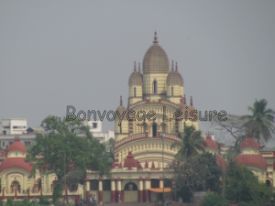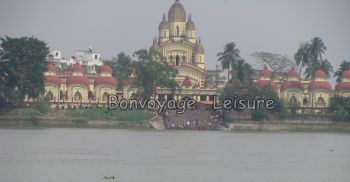 Places To Vist In Kolkata Links
Places To Vist In Kolkata Links
Dakshineswar Temple
 If someone is looking for an opportunity to immerse his soul into the never depleting ocean of devotion, the Dakshineswar Kali Temple is an ideal place to do so. This Kali Temple is one of the largest temple structures in and around Kolkata. The majestic The majestic Dakshineswar temple is dedicated to mother Goddess Kali and this temple is a pilgrimage mecca for not only Hindus but of other religious sects as well. The very name of the temple of Dakshineswar conjures the image of the spiritual giant Sri Ramakrishna Paramahansa who attained nirvana at this holy temple on the banks of the Ganges.
If someone is looking for an opportunity to immerse his soul into the never depleting ocean of devotion, the Dakshineswar Kali Temple is an ideal place to do so. This Kali Temple is one of the largest temple structures in and around Kolkata. The majestic The majestic Dakshineswar temple is dedicated to mother Goddess Kali and this temple is a pilgrimage mecca for not only Hindus but of other religious sects as well. The very name of the temple of Dakshineswar conjures the image of the spiritual giant Sri Ramakrishna Paramahansa who attained nirvana at this holy temple on the banks of the Ganges.Situated on the eastern bank of river Ganges Situated on the eastern bank of the Hooghly River, the presiding deity of the temple is Bhavatarini, an aspect of Kali, literally meaning, 'She who takes Her devotees across the ocean of existence. The temple was built by Rani Rashmoni of Janbazar, a philanthropist and a devotee of Kali in 1855.
Legend has is that in the year 1847, Rani Rashmoni who by birth was born to a fisherman’s family and later on was married to a rich Bengali merchant prepared to go for a long pilgrimage to the holy city, Varanasi to express her devotion to the Divine Mother. But on the night prior to her scheduled pilgrimage journey date to Varanasi, Rani Rashmoni was blessed with a divine vision which directed her to build a temple on the bank of river Ganges in Bengal. It is said that Goddess Kali appreared and said she would manifest herself in the image over there and accept her devotion. Profoundly affected by the dream, Rani immediately looked for and purchased land, and promptly began construction of the temple. The large temple complex was built between 1847 and 1855. The 25 acre plot was bought from an Englishman, John Hastie and was then popularly known as Saheban Bagicha - partly old Muslim burial ground shaped like a tortoise, considered befitting for the worship of Shakti according to Tantra traditions.
The temple and its adjoining area cover about 25 acres of land, making it one of the largest temples in Kolkata. The main temple premise is about 46 sq ft and rises over 100 feet high. The roof of the temple spires has been artistically grooved, resembling the Pirhas.The temple compound, apart from the nine-spired main temple, contains a large courtyard surrounding the temple, with rooms along the boundary walls. There are twelve shrines dedicated to Shiva—Kali's companion—along the riverfront, a temple to Radha-Krishna, a bathing ghat on the river, a shrine dedicated to Rani Rashmoni. The chamber in the northwestern corner just beyond the last of the Shiva temples, is where Ramakrishna spent a considerable part of his life.
The first priest of Dakshineswar Temple was Ramkumar, who was the elder brother of Ramakrishna. After ceremonial After the ceremonial change of guard, wherein the baton of priesthood was bestowed upon Sri Ramakrishna, a new chapter in India's spiritual life began to unfold. In later days, everyone becomes aware about the realities how Rama Krishna derived his Liberation and trance by the touch of the image of Goddess Kali there and acquired the supernatural power and became an ascetic with divine austerity. 

According to his chief disciple, the great Swami Vivekananda, the most wonderful part of Sri Ramakrishna's life was that his work was just near a city, which had run mad after Western and Occidental thoughts. A city, which become more Europeanized then any other city in India. And what is more baffling is the fact that being born to a high caste Brahmin family, he had choosen the Dakshineswar temple as his alma-mater, which incidentally was built by the daughter of a low caste fisherman. Strange are the ways of the lord.
0 min read

 Back to Previous Section
Back to Previous Section